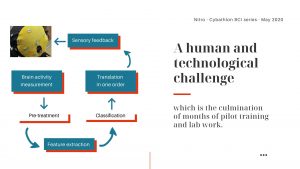Definition
A system linking the brain and a computer; this device allows “thought control” of a computer, prosthesis, or any other automated system, without using the arms, hands or legs.
Objective
Enable people with major disabilities to regain a certain degree of autonomy.
A few examples:
- Individuals with quadriplegia or locked-in syndrome (patient who has all his mental faculties but can only move his eyelids) could for example control an exoskeleton to move around,
- Amputees could control the movements of their prosthesis,
- People who are speechless could speak through a computer…
- Etc.
There are many potential applications, including for healthy people with for example the field of video games.
How does it work?
- An MCI or BCI includes a system for acquiring (=recording) and processing brain signals and a system for classifying and then translating these signals into commands (writing on a screen, movement of a prosthesis, in our case controlling a vehicle in a video game,…).
- 1st step: recording of brain activity via electrodes placed on the skull, on the surface of the brain or inside. In our case, we will use a cloth helmet equipped with several electrodes (electroencephalogram or EEG).
- The electrodes are connected to external software that classifies, analyzes and interprets the brain signals and then restores them in the form of commands that are executed by the controlled machine.
How is it used?
- The user focuses on an external stimulation, or imagines performing a movement or executes a mental task (mental arithmetic for example).
- These tasks generate characteristic and measurable brain activity.
- These signals will be transmitted to a computer which will extract the useful data, then transforms them into commands for the machine (prosthesis, exoskeleton, video game,…).
- Most often, MCIs operate in closed loops, i.e. the user observes the result of his command, then adapts his thinking, gradually refining the precision of the command produced by the system. This allows the user to progress in the mastery of the ICM.




